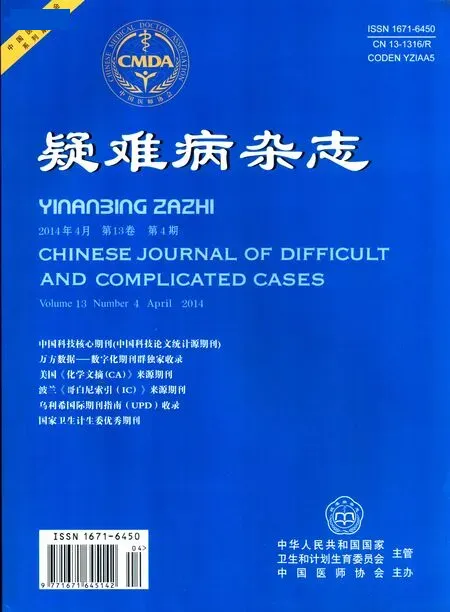肝素结合表皮生长因子对小肠I/R损伤的保护作用及其研究进展
刘志刚综述 李文志审校
综 述
肝素结合表皮生长因子对小肠I/R损伤的保护作用及其研究进展
刘志刚综述 李文志审校
肝素结合表皮生长因子;小肠缺血再灌注损伤;微循环;肠道黏膜屏障
小肠缺血再灌注(ischemia/reperfusion,I/R)损伤是临床上常见的急危重症,可发生在许多临床案例中,包括低血流量状态下的心脏功能不全、肠系膜动脉栓塞、小肠移植、失血性休克及坏死性小肠结肠炎(necrotizing enterocolitis,NEC)等[1]。小肠I/R损伤可导致微循环炎性反应,黏膜细胞凋亡[2],肠道黏膜通透性增加,进而导致全身炎性反应综合征(systemic inflammatory response syndrome,SIRS)[3,4]。如果得不到及时而有效的控制,SIRS还可能进一步发展为多器官功能障碍综合征(multiple organ dysfunction syndrome,MODS),严重影响患者的预后。
有实验研究表明,在施行缺氧复氧的小肠内皮细胞(intestinal epithelial cells,IEC)以及发生I/R损伤的小肠中,内源性肝素结合表皮生长因子(heparin-binding epidermal growth factor,HB-EGF)的表达明显增加[5]。Martin等[6]研究发现,在小肠I/R发生前、后或发生过程中给予HB-EGF均可降低小肠的组织学损伤程度,发挥保护作用,并且随着HB-EGF剂量的增加这种保护作用更加明显。由此可见,HB-EGF与小肠I/R损伤之间存在着密切的联系,现就此作一综述。
1 HB-EGF概述
1.1 HB-EGF的来源与结构 HB-EGF最初发现于U-937巨噬细胞样培养液中,后被确定为EGF超家族的一员。在人类体内,HB-EGF的基因位于第5号染色体上,由6个外显子和5个内含子共同组成,长约14 kb。在体内,HB-EGF首先被合成为一种由208个氨基酸组成的的跨膜糖蛋白前体(proHB-EGF),其中包含信号肽、前肽、sol-HB-EGF、近膜区、跨膜区和胞质区等。后经酶裂解为一种可溶性的分泌型成熟体,即sHB-EGF,由86个氨基酸残体组成,含有2个功能结构域:一个是EGF样结构域,位于C末端;另一个为肝素结构域,位于N末端。包括内皮细胞在内的许多类型的细胞都可产生HB-EGF,并作为这些细胞的自分泌型生长因子发挥作用。
1.2 HB-EGF的功能与作用机制 作为EGF家族中的一员,HB-EGF可结合并激活EGF受体(EGFR/HER1/ErbB-1),另外HB-EGF也可以激活ErbB-4(HER4)促进有丝分裂,与HB-EGF特异性非酪氨酸蛋白激酶受体N-精氨酸二碱基转化酶(N-arginine dibasic convertase,NRDc)结合时则产生趋化作用[7~9]。
实验研究表明,在发生组织损伤、低氧、氧化应激及小肠内皮创伤[10~13]时HB-EGF的表达明显增加[14]。由此可见,HB-EGF对多种类型细胞的促有丝分裂作用及其在组织中的广泛表达都意味着HB-EGF在机体内具有重要的生物学作用。
2 HB-EGF与小肠I/R损伤
目前研究表明,HB-EGF能够降低小肠I/R损伤后的炎性反应、减少上皮细胞凋亡,诱导肠上皮细胞增殖[15],并能够改善小肠微循环、保护肠道屏障功能,从而发挥保护作用。
2.1 HB-EGF降低炎性反应、抗细胞凋亡的作用 相关研究显示,凋亡很可能是I/R损伤发生后细胞死亡的主要原因[2]。I/R损伤后体内各种炎性细胞的激活、活性氧自由基(ROS)及炎性因子释放增多会导致黏膜细胞发生凋亡[16]。炎性细胞如中性粒细胞的活化可使其成为ROS、蛋白水解酶及炎性因子的主要来源[17,18]。
研究表明,HB-EGF能够减少诱导型一氧化氮合酶(iNOS)[19]、ROS[20]及NF-κB[21]等的生成,并且抑制小肠I/R损伤后炎性细胞向受损组织侵润[22]。Rocourt等[23]发现在小肠缺血过程中给予HB-EGF可明显下调再灌注后4、6、8 h时血浆中TNF-α、IL-6和IL-1β等炎性因子的水平,同时检测到再灌注30、60 min时小肠组织中TNF-α、IL-6和IL-1β mRNA的表达水平也显著降低,而HB-EGF基因的缺失却能够增加失血性休克复苏(hemorrhagic shock/resuscitation,HS/R)后的肠上皮细胞凋亡[24]。由此可推断,HB-EGF可通过降低iNOS、ROS、NF-κB及炎性因子的表达来减少小肠上皮细胞的凋亡,以此来保护I/R损伤后的小肠。
2.2 HB-EGF对小肠I/R损伤后黏膜屏障功能的影响 小肠黏膜由一层增殖型上皮细胞组成,它作为内外环境之间的屏障对抗有害物质侵入上皮下组织。即使发生严重的黏膜破坏后,小肠上皮细胞的增殖能力都能够使小肠迅速修复愈合[25]。但是,如果在损伤过程中表面上皮细胞和绒毛结构缺失就会破坏肠道屏障功能,使细菌发生移位,导致毒素、抗原、蛋白酶和其他分子吸收进入体内,导致局部感染而后波及到远隔器官。因此促进小肠绒毛结构早期恢复并有效地保护肠道屏障功能是避免小肠I/R损伤引起全身反应的关键所在。
研究表明给予外源性HB-EGF可以保护小肠的肠道屏障功能[26],并且内源性HB-EGF在保护肠道屏障功能的过程中也起着重要的作用。El-Assal等[28]通过对敲除HB-EGF基因[HB-EGF(-/-) knockout,KO]小鼠的研究发现,结扎其肠系膜上动脉45 min后恢复灌注3 h,与正常小鼠相比HB-EGF(-/-)小鼠不仅组织学损伤程度加重,小肠绒毛结构恢复缓慢,且其肠道屏障通透性也明显升高[27]。而Zhang等[29]也发现,相比之下施行HS/R后HB-EGF(-/-)小鼠的组织学损伤程度明显加重,而其肠道黏膜屏障通透性也显著升高。而过度表达HB-EGF基因的小鼠对HS/R的耐受能力明显增强,且在其组织学损伤程度下降的同时肠道黏膜屏障通透性也比正常小鼠低,但使用了CRM197(HB-EGF特异性阻滞剂)后不仅组织学损伤加重而且其肠道黏膜屏障通透性也增加。同样HB-EGF基因的过度表达可降低小鼠NEC的发病率并改善肠道黏膜屏障功能,而敲除HB-EGF基因则出现与此相反的结果[30,31]。由此可见内源性HB-EGF在I/R损伤后小肠组织学损伤和肠道黏膜屏障功能的恢复过程中发挥着极其关键的作用。
HB-EGF保护肠道黏膜屏障功能的具体机制尚未完全明确。除上述的减少上皮细胞的凋亡外,对小肠干细胞(intestinal stem cells,ISCs)的保护也可能是其保护肠道黏膜屏障功能的机制。ISCs的多功能性、自我更新能力及其增殖能力对保证小肠上皮细胞的完整性具有重要作用[32]。当发生小肠缺血时,ISCs会受到严重的损伤,从而扰乱正常的内环境及肠道屏障功能。Chen等[33]研究发现,给予HB-EGF能够保护包括ISCs在内所有的小肠上皮细胞系免受损伤,同时HB-EGF也可以保护体外实验中低氧损伤的ISCs,并提升ISCs的活性和存活能力。通过进一步的研究发现HB-EGF对ISCs等细胞的保护作用涉及到EGF受体的活化及MEK1/2和PI3K信号通路的介导。因此,HB-EGF对肠道屏障功能的保护作用很可能是通过对ISCs的保护来实现的。另外,中性粒细胞(neutrophil,PMN)与内皮细胞(endothelial cell,EC)之间的相互作用在小肠I/R损伤的发病机制中发挥着重要的作用[34]。而Zhang等[35]发现HB-EGF可减弱HS/R后的PMN-EC黏附,并可通过P13K通路抑制NF-κB的活化,同时调节EC中黏附分子的转录并减少PMN中ROS的生成来抑制黏附分子的活化,抑制炎性反应的发展,以此来保护小肠屏障功能。
2.3 HB-EGF与I/R损伤后小肠微循环 由于与其他器官相比小肠具有较高的氧需求量,因此小肠极易发生I/R损伤。而HS/R、NEC等引起小肠发生I/R损伤的原因之一就是小肠微循环血供障碍,其特点包括血管收缩及低氧灌注[36,37]。El-Assal等[28]通过对HS/R大鼠模型的研究结果显示,在复苏的同时静脉注射HB-EGF后与HS/R组相比不仅其小肠的组织学损伤程度减轻,并且分别在HS/R后1 h和3 h时其小肠的微循环血流量显著增加。而在对NEC新生小鼠模型的研究中同样发现给予HB-EGF后,利用分子探针在电子显微镜下可观察到其小肠绒毛和黏膜下微循环血流量明显增加,且与NEC的发生率及小肠组织学损伤程度呈负相关[38]。而为探讨内源性的HB-EGF对小肠I/R损伤后微循环灌注的影响,许多科学家也做了大量的研究,其中Zhang等[39]经研究发现,HS/R后HB-EGF(-/-)小鼠小肠微循环低灌注情况更加严重,而在复苏的同时给予HB-EGF(-/-)小鼠HB-EGF可明显改善这一情况[39]。由此可见,无论是外源性HB-EGF还是内源性HB-EGF对小肠I/R损伤后小肠微循环灌注的维持和恢复情况都起着极其重要的作用,而且EGF家族的其他成员并不能弥补内源性HB-EGF的缺失所带来的影响。
HB-EGF究竟是通过何种途径来维持I/R损伤后小肠微循环的灌注情况呢?众所周知,小肠微动脉是调节小肠血流量的主要阻力动脉。而Zhou等[40]发现,HB-EGF能够增加成年大鼠终末肠系膜动脉的直径,在新生大鼠肠系膜动脉中同样发现了舒血管作用,并且在人黏膜下动脉的观察中得到进一步证实。为明确HB-EGF舒血管作用的机制,Zhou等在进一步的研究中发现HB-EGF可减轻内皮素-1(endothelin-1,ET-1)引起的肠系膜动脉收缩,同时增加人小肠微血管内皮细胞(human intestinal microvascular endothelial cell,HIMEC)中ETB受体蛋白的表达并刺激细胞内钙离子调动,而ETB受体拮抗剂可阻滞成年大鼠动脉内HB-EGF的舒血管作用,同样NO合酶抑制剂可阻滞HB-EGF对新生大鼠和人类婴儿动脉的舒血管作用,因此HB-EGF很可能是通过增加内皮细胞中内源性NO的生成并激活ETB受体调动细胞内钙离子释放舒血管物质来介导舒血管作用[42]。由此可见,ETB受体和NO以及对细胞内钙离子的调动在HB-EGF介导舒血管作用的过程中发挥着至关重要的作用。另有文献报道,位于微循环毛细血管和后毛细血管的周细胞(pericytes)同样是微循环血流和毛细血管再生的重要调控者[41]。Yu等[42]在HB-EGF对周细胞影响的研究中发现,HB-EGF可通过与细胞表面的EGF酪氨酸激酶受体相互作用促进分化的C3H/10T1/2细胞(周细胞样细胞)的增殖,并保护其免受低氧引起的凋亡。而在培养的原始周细胞中也证实了HB-EGF的这一特殊作用。另外,在动物模型试验中HB-EGF同样可以保护小肠I/R损伤的周细胞。由于周细胞在调节毛细血管血流及再生的过程中发挥着关键的作用,因此HB-EGF对小肠I/R损伤后微循环血流的调节与其对周细胞的促有丝分裂作用和抗凋亡作用有关。
3 结语与展望
综上所述,HB-EGF不仅可以通过对抗炎性反应、改善肠道微循环灌注来保护I/R小肠黏膜细胞,并且对肠道黏膜屏障功能也具有一定的保护作用,以此避免肠道黏膜通透性增加引发SIRS及MODS的发生,改善小肠I/R损伤的预后。同时一些研究表明,HB-EGF对小肠I/R损伤后远隔器官[43]及脑I/R损伤[44]也具有保护作用,表明HB-EGF具有全身性抗炎药物的潜质。但由于HB-EGF可介导肾脏I/R损伤的发生[45],因此HB-EGF是否可用于休克这种全身性低灌注情况的治疗还有待于进一步的研究。并且HB-EGF抗细胞凋亡、保护肠道黏膜屏障功能及改善微循环灌注的机制并未完全明确,因此还需要大量实验研究来阐明其保护机制,为HB-EGF应用于临床提供有力支持。
1 ParkSDA,Granger DN.ContributionSof ischemia and reperfusion to mucosal lesion formation[J]. Am J Physiol,1986,250(6 Pt1):749-753.
2 Shah KA,Shurey S,Green CJ.ApoptosiSafter intestinal ischemia-reperfusion injury[J]. Transplantation,1997,64(10):1393-1397.
3 Rotstein OD. PathogenesiSof multiple organ dysfunction syndrome:Gut origin,protection,and decontamination[J]. Surg Infect,2000,1(3):217-223.
4 Fink MP,Delude RL. Epithelial barrier dysfunction:A unifying theme to explain the pathogenesiSof multiple organ dysfunction at the cellular level[J].Crit Care Clin,2005,21:117-134.
5 Hayward R,Lefer A. Time course of endothelial-neutrophil interaction in splanchnic artery ischemia-reperfusion[J]. Am J Physiol,1998,275:H2080-2086.
6 Martin AE,Luquette MH,Besner GE. Timing,route,and dose of administration of heparin-binding epidermal growth factor-like growth factor in protection against intestinal ischemia-reperfusion injury[J]. J Pediatr Surg,2005,40(11):1741-1747
7 Nishi E,Prat A,Hospital V,et al. N-arginine dibasic convertase iSa specific receptor for heparin-binding EGF-like growth factor that mediateScell migration[J]. EMBO J,2001,20(13):3342-3350.
8 Nishi E,Klagsbrun M. Heparin-binding epidermal growth factor-like growth factor (HB-EGF) iSa mediator of multiple physiological and pathological pathways[J].Growth Factors,2004,22:253-260.
9 Junttila TT,Sundvall M,Maatta JA,et al. Erbb4 and itSisoforms:selective regulation of growth factor responseSby naturally occurring receptor variants[J]. TrendSin Cardiovascular Medicine,2000,10(7):304-310.
10 CribbSRK,Harding PA,Luquette MH,et al. EndogenouSproduction of heparin-binding EGF-like growth factor during murine partial-thicknesSburn wound healing[J]. J Burn Care Rehabil,2002,23(2):116 -125.
11 Jin K,Mao XO,Sun Y,et al. Heparin-binding epidermal growth factor-like growth factor:hypoxia-inducible expression in vitro and stimula-tion of neurogenesiSin vitro and in vivo[J]. J Neurosci,2002,22(13):5365-5373.
12 Frank GD,Mifune M,Inagami T,et al. Distinct mechanismSof receptor and nonreceptor tyrosine kinase activation by reactive oxygen specieSin vascular smooth muscle cells:role of metalloprotease and protein kinase C-delta[J]. Mol Cell Biol,2003,23(5):1581-1589.
13 ElliSPD,Hadfield KM,Pascall JC,et al. Heparin-binding epidermal-growth-factor-like growth factor gene expression iSinduced by scrape-wounding epithelial cell monolayers:involvement of mitogen-activated protein kinase cascades[J]. Biochem J,2001,354:99 -106.
14 El-Assal ON,Besner GE.Heparin-binding epidermal growth factorlike growth factor and intestinal ischemia-reperfusion injury[J].Semin Pediatr Surg,2004,13(1):2-10.
15 沈绦华,施诚仁. 肝素结合表皮生长因子和肠缺血再灌注[J]. 国外医学外科学分册,2005,32:260-263.
16 Ikeda H,SuzukiY,Suzuki M,et al. ApoptosiSiSa major mode of cell death caused by ischemia and ischemia / reperfusion injury to the rat intestinal epithelium[J].Gut,1998,42(4):530-537.
17 Tsukimori K,Tsushima A,Fukushima K,et al. Neutrophil-derived reactive oxygen specieScan modulate neutrophil adhesion to endothelial cellSin preeclampsia[J]. Am J Hypertens,2008,21(5):587-591.
18 Zarbock A,Ley K. Neutrophil adhesion and activation under flow[J]. Microcirculation,2009,16(1):31-42.
19 Lara-Marquez M,Mehta V,Michalsky M,et al. Heparin-binding EGF-like growth factor down regulateSproinflammatory cytokine-induced nitric oxide and inducible nitric oxide synthase production in intestinal epithelial cells[J]. Nitric Oxide,2002,6(2):142-152.
20 Kuhn M,Xia G,Mehta V,et al. Heparin-binding EGF-like growth factor (HB-EGF) decreaseSoxygen free radical production in vitro and in vivo[J]. Antioxid Redox Signal,2002,4(4):639-646.
21 Mehta V,Besner G. Inhibition of NF-kappa B activation and itStarget geneSby heparin-binding epidermal growth factor-like growth factor[J]. J Immunol,2003,171(11):6014-6022.
22 Xia G,Martin AE,Besner GE. Heparin-binding EGF-like growth factor downregulateSexpression of adhesion moleculeSand infiltration of inflammatory cellSafter intestinal ischemia/reperfusion injury[J]. J Pediatr Surg,2003,38(3):434-439.
23 Rocourt D,Mehta V,Besner G. Heparin-binding EGF-like growth factor decreaseSinflammatory cytokine expression after intestinal ischemia/reperfusion injury[J]. J Surg Res,2007,139(2):269-273.
24 Zhang H,Radulescu A,Besner G. Heparin-binding epidermal growth factor-like growth factor iSessential for preservation of gut barrier function after hemorrhagic shock and resuscitation in mice[J]. Surgery,2009,146(2):334-339.
25 Potten CS. Epithelial cell growth and differentiation. II. Intestinal apoptosis[J]. Am J Physiol,1997,273(2Pt1):253-257.
26 El-Assal ON,Radulescu A,Besner GE. Heparin-binding EGF-like growth factor preserveSmesenteric microcirculatory blood flow and protectSagainst intestinal injury in ratSsubjected to hemorrhagic shock and resuscitation[J]. Surgery,2007,142(2):234-242.
27 El-Assal O,Paddock H,Marquez A,et al. Heparin-binding epidermal growth factor-like growth factor gene disruption iSassociated with delayed intestinal restitution,impaired angiogenesis,and poor survival after intestinal ischemia in mice[J]. J Pediatr Surg ,2008,43(6):1182-1190.
28 Zhang H,Radulescu A,Besner G. Heparin-binding epidermal growth factor-like growth factor iSessential for preservation of gut barrier function after hemorrhagic shock and resuscitation in mice[J]. Surgery,2009,146(2):334-339.
29 Zhang HY,Radulescu A,Chen CL,et al. Mice overexpressing the gene for heparin-binding epidermal growth factor-like growth factor (HB-EGF) have increased resistance to hemorrhagic shock and resuscitation[J]. Surgery,2011,149(2):276-283.
30 Radulescu A,Yu X,OrvetSN,et al. Deletion of the Heparin-binding EGF-like growth factor gene increaseSsusceptibility to necrotizing enterocolitis[J]. J Pediatr Surg,2010,45(4):729-734.
31 Radulescu A,Zhang H,Yu X,et al.Heparin-binding EGF-like Growth Factor Overexpression in Transgenic Mice IncreaseSResistance to Necrotizing Enterocolitis[J]. J Pediatr Surg,2010,45(10):1933-1939.
32 Potten CS,Gandara R,Mahida YR,et al. The stem cellSof small intestinal crypts:where are they[J].Cell Prolif,2009,42(6):731-750.
33 Chen CL,Yu X,JameSIO,et al. Heparin-binding EGF-like growth factor protectSintestinal stem cellSfrom injury in a rat model of necrotizing enterocolitis[J]. Lab Invest,2012,92(3):331-344.
34 OlanderSK,Sun Z,B orjesson A,et al. The effect of intestinal ischemia and reperfusion injury on ICAM-1 expression,endothelial barrier function,neutrophil tissue influx,and protease inhibitor levelSin rats[J]. Shock,2002,18(1):86-92.
35 Zhang HY,JameSI,Chen CL,et al. Heparin-binding epidermal growth factor-like growth factor (HB-EGF) preserveSgut barrier function by blocking neutrophil-endothelial cell adhesion after hemorrhagic shock and resuscitation in mice[J]. Surgery,2012,151(4):594-605.
36 Seal J,Gewertz B. Vascular dysfunction in ischemia-reperfusion injury[J]. Ann Vasc Surg,2005,19(4):572-584.
37 Thomson A,Keelan M,Thiesen A,et al. Pathophysiology of mesenteric ischemia/reperfusion:A review[J]. Dig DiSSci,2001,46(12):2555-2566.
38 Yu X,Radulescu A,Zorko N,et al. Heparin-binding EGF-like growth factor increaseSintestinal microvascular blood flow in necrotizing enterocolitis[J]. Gastroenterology ,2009,137(1):221-230.
39 Zhang HY,Radulescu A,Chen Y,et al. HB-EGF improveSintestinal microcirculation after hemorrhagic shock[J]. J Surg Res,2010,171(4):218-225.
40 Zhou Y,Brigstock D,Besner GE. Heparin-binding EGF-like growth factor iSa potent dilator of terminal mesenteric arterioles[J]. Microvasc Res,2009,78(1):78-85.
41 Hirschi KK,D’Amore PA. PericyteSin the microvasculature[J]. Cardiovascular Research,1996,32(4):687-698.
42 Yu X,Radulescu A,Chen CL,et al.Heparin-binding EGF-Like growth factor protectSpericyteSfrom injury[J].J Surg Res,2012,172(1):165-176.
43 JameSIA,Chen CL,Huang G,et al. HB-EGF protectSthe lungSafter intestinal ischemia/reperfusion injury[J]. J Surg Res,2010,163(1):86-95.
44 Oyagi A,Morimoto N,Hamanaka J,et al. Forebrain specific heparin-binding epidermal growth factor-like growth factor knockout mice show exacerbated ischemia and reperfusion injury[J]. Neuroscience,2011,185:116-124.
45 Mulder GM,Nijboer WN,Seelen MA,et al. Heparin binding epidermal growth factor in renal ischaemia_reperfusion injury[J]. J Patho, 2010,221(2):183-192.
150086 哈尔滨医科大学附属第二医院麻醉科/黑龙江省普通高等学校麻醉基础理论与应用研究重点实验室
李文志,E-mail:wenzhili9@126.com
10.3969 / j.issn.1671-6450.2014.04.037
2013-09-05)

